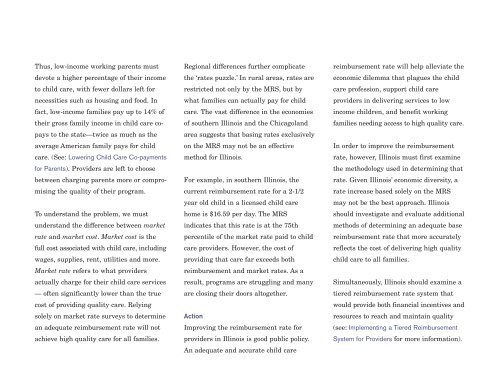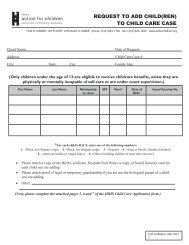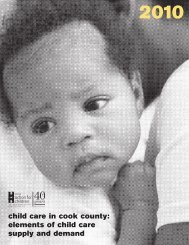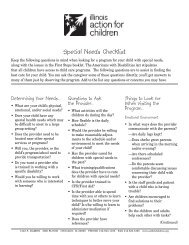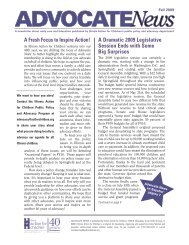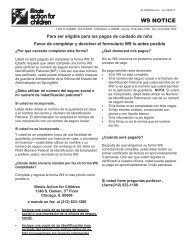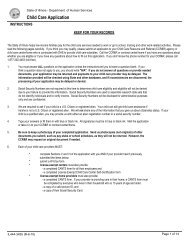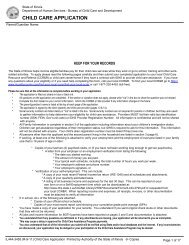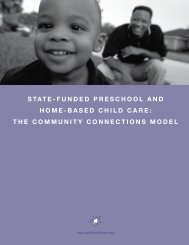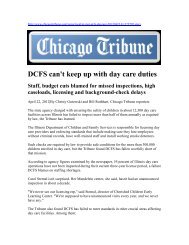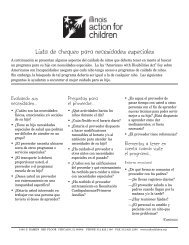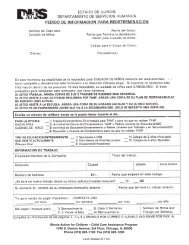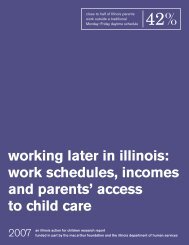AFC Policy Platform - Illinois Action for Children
AFC Policy Platform - Illinois Action for Children
AFC Policy Platform - Illinois Action for Children
- No tags were found...
Create successful ePaper yourself
Turn your PDF publications into a flip-book with our unique Google optimized e-Paper software.
Thus, low-income working parents mustdevote a higher percentage of their incometo child care, with fewer dollars left <strong>for</strong>necessities such as housing and food. Infact, low-income families pay up to 14% oftheir gross family income in child care copaysto the state—twice as much as theaverage American family pays <strong>for</strong> childcare. (See: Lowering Child Care Co-payments<strong>for</strong> Parents). Providers are left to choosebetween charging parents more or compromisingthe quality of their program.To understand the problem, we mustunderstand the difference between marketrate and market cost. Market cost is thefull cost associated with child care, includingwages, supplies, rent, utilities and more.Market rate refers to what providersactually charge <strong>for</strong> their child care services— often significantly lower than the truecost of providing quality care. Relyingsolely on market rate surveys to determinean adequate reimbursement rate will notachieve high quality care <strong>for</strong> all families.Regional differences further complicatethe ‘rates puzzle.’ In rural areas, rates arerestricted not only by the MRS, but bywhat families can actually pay <strong>for</strong> childcare. The vast difference in the economiesof southern <strong>Illinois</strong> and the Chicagolandarea suggests that basing rates exclusivelyon the MRS may not be an effectivemethod <strong>for</strong> <strong>Illinois</strong>.For example, in southern <strong>Illinois</strong>, thecurrent reimbursement rate <strong>for</strong> a 2-1/2year old child in a licensed child carehome is $16.59 per day. The MRSindicates that this rate is at the 75thpercentile of the market rate paid to childcare providers. However, the cost ofproviding that care far exceeds bothreimbursement and market rates. As aresult, programs are struggling and manyare closing their doors altogether.<strong>Action</strong>Improving the reimbursement rate <strong>for</strong>providers in <strong>Illinois</strong> is good public policy.An adequate and accurate child carereimbursement rate will help alleviate theeconomic dilemma that plagues the childcare profession, support child careproviders in delivering services to lowincome children, and benefit workingfamilies needing access to high quality care.In order to improve the reimbursementrate, however, <strong>Illinois</strong> must first examinethe methodology used in determining thatrate. Given <strong>Illinois</strong>’ economic diversity, arate increase based solely on the MRSmay not be the best approach. <strong>Illinois</strong>should investigate and evaluate additionalmethods of determining an adequate basereimbursement rate that more accuratelyreflects the cost of delivering high qualitychild care to all families.Simultaneously, <strong>Illinois</strong> should examine atiered reimbursement rate system thatwould provide both financial incentives andresources to reach and maintain quality(see: Implementing a Tiered ReimbursementSystem <strong>for</strong> Providers <strong>for</strong> more in<strong>for</strong>mation).


